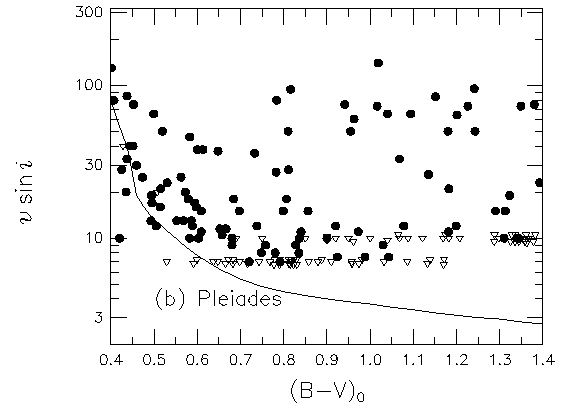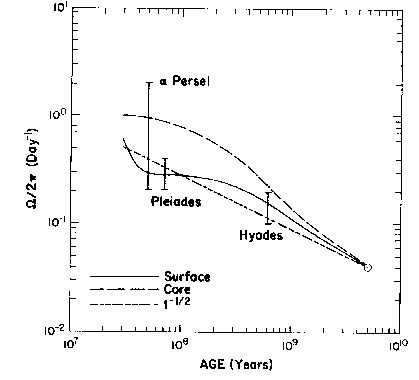Solar-Type Stars: Basic Information on Their Characterization and Classification
David R. Soderblom & Jeremy R. King (Space Telescope Science Institute)
6. Duplicity and Angular Momentum
6.1 Companionship
Companionship is a key property of stars, and especially so for solar-type
stars because of their convective envelopes. This is because a nearby star
can exert enough tidal force to make the star rotate synchronously with
the orbital motion. Companionship is also a key issue for star formation.
Mayor and Latham are surveying large numbers of solar-type stars with
radial-velocity observations. Their accuracy is now 100 m s-1> or better.
Close Companions:
We know that for close binaries (Porb less than 10 days), the companion can
induce synchronous rotation, leading to much higher surface rotation than would
be seen in a single star of the same age. Such stars may evolve much more
rapidly than single stars because of higher, constant angular momentum loss
and spiraling-in. Systems of sufficiently short period (less than about 10
days) are suspected of suppressing Li depletion in the main sequence phase.
This suggests suppression of radially-differential rotation, which could have
much more significant effects.
Distant Companions:
How about more distant companions? They can disrupt planetary systems,
of course, but they probably do not affect the structure or evolution of
the primary star.
Very-Low-Mass Companions:
A notable case is 51 Pegasi:
- Mayor & Queloz (1995; and Marcy & Butler 1996) see radial velocity
variations consistent with a 0.5 MJup companion in a Keplerian orbit.
- Gray (1997) sees line bisector variations with the same 4.2-day period
that he says are non-radial pulsations. (At the time this is written there
are new observations appearing, and the reader is referred to the
journals.)
- No photometric variations are seen to one part in 5,000.
- The observation sets are disjoint in that Gray has enough resolution
to see the line bisectors (Marcy doesn't), but Gray does not have the
absolute accuracy needed to see overall line shifts (Marcy does).
- Who's right? Maybe both are and the companion is exciting low-level
oscillations in the primary star.
- Hall and Lockwood termed 51 Peg a solar twin (in the sense of Cayrel
noted earlier), but the phenomenon seen by Gray rules that out.
6.2. The Role of Rotation
Angular momentum is a fundamental property of a star, of course, and it
is at the heart of the rich phenomenology seen in solar-type stars.
Clearly rotation, and differences in rotation, lead to observable
micro-properties, notably the many forms of activity we can now see in
other stars. But does rotation lead to differences in the macro-properties
of a star?
Some basics:
- We know solar-type stars reach the ZAMS with a spread in surface
rotation of a factor of at least 20 (Soderblom et al. 1993a). Figure 14
shows the distribution of rotational velocities for solar-type stars in the
Pleiades, which, at 100 Myr age, is Zero-Age Main Sequence for stars
near 1 Msun. Note the huge spread, with the most rapidly rotating stars
spinning at about 100 times the present solar rate. And yet most of this
cluster's stars have low rotation, v sin i < 10 km s-1.
- Solar-type stars lose angular momentum while they are on the main
sequence. The dynamo mechanism that generates magnetic fields includes
feedback, so we believe there is convergence in rotation with time. Figure 15
shows a model of such convergence (see Charbonneau 1992),
based on an assumed loose coupling between the radiative core and the
convective envelope. Thus the star is believed to spin up just before
reaching the ZAMS, at which point the surface loses angular momentum
and the core decouples from the envelope. This allows the surface to
spin down faster than it would otherwise, with gradual reconnection
over time.
- Rapid rotation and excess lithium are correlated in stars of the
Pleiades (Soderblom et al. 1993b). We suspect rotation influences Li
depletion, but there is logically no feedback mechanism, so spreads in Li
abundance are expected to perpetuate themselves. For example, the solar-age
stars in M67 have at least a 10X spread in Li (Jones et al. 1998).

FIGURE 14:
Rotation rates (v sin i, in km s-1 versus dereddened
B-V color, for stars in the Pleiades, from SSHJ. The triangles represent
upper limits to v sin i. The line shows the run of rotation with color for
stars of the Hyades.}

FIGURE 15:Model of the evolution of
rotation in a 1 M\odot
star (see Charbonneau 1992). The separate curves show how the surface
and core spin at different rates, with convergence achieved by the age
of the Sun. The Skumanich t-1/2 relation is shown for reference.}
[First | Prev | Next ]
[Contents]


